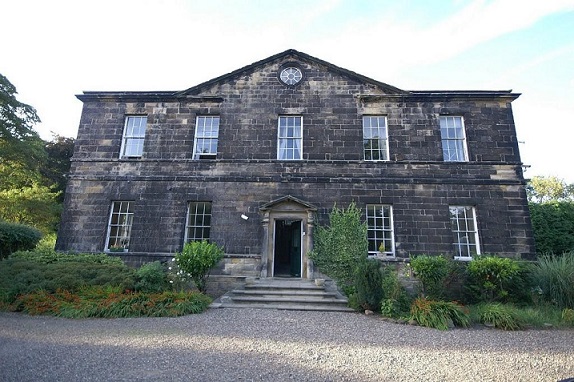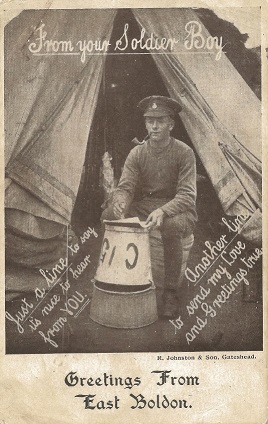

Great War 1914-18
Scotts House Camp was the base of the 3rd(Res)Bn, Northumberland Fusiliers who moved there shortly after mobilization and also the home of the NF Depot training Companies. Although the camp has gone the farm(?) around which it was located still remains to this day.
The Camp was commanded by Lieutenant-Colonel Richard Foulis Roundell 1914-18 which housed 27,000 soldiers. Lieutenant-Colonel Richard Foulis Roundell name pops up again in 1922 at the unveiling of the East Boldon War Memorial.
"Boldon War Memorial, which stands on Front Street, East Boldon, was unveiled on April 29 1922 by Lt-Col RS Roundell MP, who had been in charge of Boldon camp during the First World War, which housed 27,000 soldiers.It commemorates 65 men of West and East Boldon who died during the First World War and following the Second World War the names of 39 men were added. On the memorial is Royal Navy leading signalman Richard Applegarth, who was 29 when he died in the sinking of HMS Hood by the Bismark in 1941. Also on the memorial is Robert Hanney aged 29, a gunner in a tank which took part in the Battle of Cambrai in 1917."
Newcastle Evening Chronicle
The location of the camp had quite an impact on Boldon of the time, those who did not serve did there part by suporting those who did. One of the many activities that took place in the area was a Concert arranged by Mr F. A. Jackson from East Boldon, performed by the band of the Northumberland Fusiliers and attended by the Camp Commander. The purpose of which was to raise funds for the soldiers and their families.

Scots House Camp
The Sunderland Daily echo 3rd of July 1919 posted and advert for a sale of the remanents of Scotts Camp which gives us a bit of an insight into the structure of the camp. We know from photos that the soldiers lived in tents but obviously key buildings were more of a semi permanent construction. The items are listed below.
Guard Room Hut 110ftx 20ft8in x 10ft 9in with 8ft Verandah. Containing 4 zinc-lined cells, 4 large asbestos-lined rooms ???? yard with corrugated iron surround, ablution bench and latrine etc.
15 Living Huts 120ft 8in x 20ft8in x 10ft 7in. Framed and weather-boarded on sides and ends, felt-covered roof, line 3-ply. Boarded floor divided by 3 ply partitions into 2 rooms, 4 combustion stoves.
Power House, 20ft 8in x 12ft 4in x 10ft 9in matchboard lined 1 partition. " sleeping bunks.
Drying Rooms, 80ft 8in x 20ft 8in x 10ft 4in divided into 4 rooms each with a combustion stove.
Bath House with Brick Boiler House 74ft 6in x 14ft x 13ft 3in
Corrugated Iron Cookhouse 60ft 8in x 28ft 8in x 13ft lined 3-ply with one stone cupboard. The whole with concrete floor.
The Regimental Institute 200ft x 28ft 8in x 13ft 3in, framed and weather boarded on sides and ends and felt roof. Lined 3-ply divided by 2 partitions.
Regimental Institute Kitchen 36ft x 20ft x 11ft 3in, divided into 4 rooms.
Sergeants Mess 70ft 8in x 30ft 8in x 10 ft 9in lined 3-ply boarded floor, partitoned into messroom, bar and smokeroom.
Officers Quarters 86ft x 29ft 8in x 10ft 9in divided into 9 cubicles, lined 3-ply 7 queen stoves.
Corrugated iron oil store 8ft x 8ft.
Heavy Oil Engine water-cooled by the Parson's Motor Company, with petrol, oil and water tanks and all connections.
4 Mens Ablution Sheds 40ft x 10ft x 8ft 4in.
8 Latrines 21ft 6in x 10ft 8 in x 8ft.
10KW 250V Dynamo, Direct Current Motor and Generator by Siemens Bros.
Judging by the size and number of the buildings described, the camp was of a decent size even though temprorary in nature.
| A Soldiers Memories of Scotts Camp | |
|---|---|
| John Pearson British private served with 8th Bn Northumberland Fusiliers in Gallipoli and Egypt, 1915-1916; served with 16th Bn Northumberland Fusiliers on Western Front, 1916-1917; POW in Belgium and Germany, 1917-1918. This is reel 1 of an oral history by John himself recorded by the imperial war museum. | |
| Source: Copyright IWM | Complete interview |
| A Postcard Home | |
|---|---|
 |
A post card posted from East Boldon Post Office from a soldier based at the local camp to his family what is interesting to note is that the Posted Card says greetings from East Boldon and not West Boldon or Scotts Camp which hints at another camp located in the Boldon area specifically East Boldon. A Soldiers Christmas is a news article detailing the efforts of the local committee in raising funds for the soldiers at christmas which makes reference to a hutted Camp at South Boldon, which would be in the area of Bridle Path roughly behind East Boldon Post office. Could this be the camp referred to in the news article and Post Card.? Further articles German Prisoners at Boldon in april 1919 and Germans Repatriated Oct 1919 lends more credance to the possibility of more Camps in the Boldon area. |